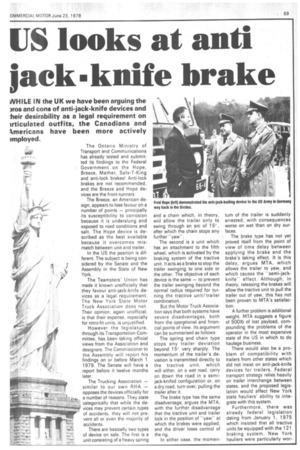US looks at anti jack-knife brake
Page 61

If you've noticed an error in this article please click here to report it so we can fix it.
WHILE IN the UK we have been arguing the 3ros and cons of anti-jack-knife devices and heir desirability as a legal requirement on irticulated outfits, the Canadians and kmericans have been more actively ?mployed.
The Ontario Ministry of Transport and Communications has already tested and submitted its findings to the Federal Government on the Hope, Breeze, Mather, Safe-T-King and anti-lock brakes! Anti-lock brakes are not recommended, and the Breeze and Hope devices are the front runners.
The Breeze, an American design, appears to lose favour on a number of points — principally its susceptibility to corrosion because it is underslung and exposed to road conditions and salt. The Hope device is described as the best available because it overcomes mismatch between unit and trailer.
In the US the position is different. The subject is being considered by the Senate and the Assembly in the State of New York, The Teamsters' Union has made it known unofficially that they favour anti-jack-knife devices as a legal requirement. The New York State Motor Truck Association does not. Their opinion, again unofficial, is that their expense, especially for retro-fit units, is unjustified.
However the legislature, through its Transportation Committee, has been taking official views from the Association and designers. The Commissioner to the Assembly will report his findings on or before March 1 1979. The Senate will have a report before it twelve months later.
The Trucking Association — similar to our own RHA — opposes the devices officially for a number of reasons. They state categorically that while the devices may prevent certain types of accidents, they will not prevent all or even the majority of accidents.
There are basically two types of device on sale. The first is a unit consisting of a heavy spring and a chain which, in theory, wiil allow the trailer only to swing through an arc of 15° , after which the chain stops any further "yaw".
The second is a unit which has an attachment to the fifth wheel, which is activated by the braking system of the tractive unit. It acts as a brake to stop the trailer swinging to one side or the other. The objective of each device is the same — to prevent the trailer swinging beyond the normal radius required for turning the tractive unit/trailer combination.
But the Motor Truck Association says that both systems have severe disadvantages, both from the operptional and financial points of View. Its argument can be summarised as follows: The spring and chain type stops any trailer deviation beyond 15° very sharply. The momentum of the trailer's deviation is transmitted directly to the tractive unit, which will either, on a wet road, carry on down the road in a semijack-knifed configuration or, on a dry road, turn over, pulling the trailer after it.
The brake type has the same disadvantage, argues the MIA, with the further disadvantage that the tractive unit and trailer lock in the position of "yaw" at which the brakes were applied, and the driver loses control of the rig.
In either case, the momen turn of the trailer is suddenly arrested, with consequences worse on wet than on dry surfaces.
The brake type has not yet proved itself from the point of view of time delay between applying the brake and the brake's taking effect. It is this delay, argues !VITA, which allows the trailer to yaw, and which causes the "semi-jackknife" effect. Although, in theory, releasing the brakes will allow the tractive unit to pull the trailer out of yaw, this has not been proven to MTA's satisfaction.
A further problem is additional weight. MTA suggests a figure of 5001b of lost payload, compounding the problems of the operator in the most expensive state of the US in which to do haulage business.
There would also be a problem of compatibility with trailers from other states which did not insist on anti-jack-knife devices for trailers. Federal transport strategy relies heavily on trailer interchange between states, and the proposed legislation would affect New York state hauliers' ability to integrate with this system.
Furthermore, there was already federal legislation dating from January 1, 1975 which insisted that all tractive units be equipped with the 121 braking system. New York hauliers were particularly wor




































































































































































